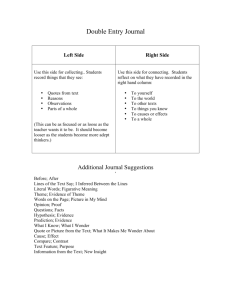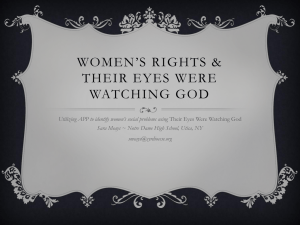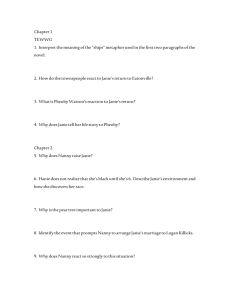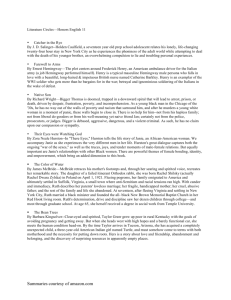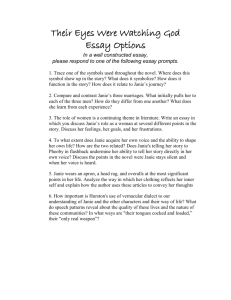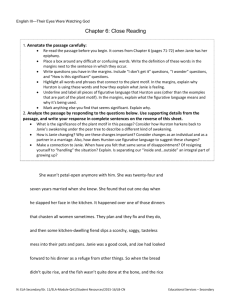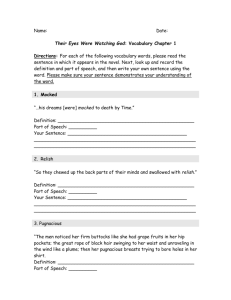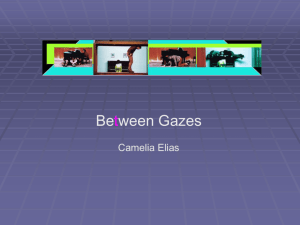Intro to Hurston
advertisement
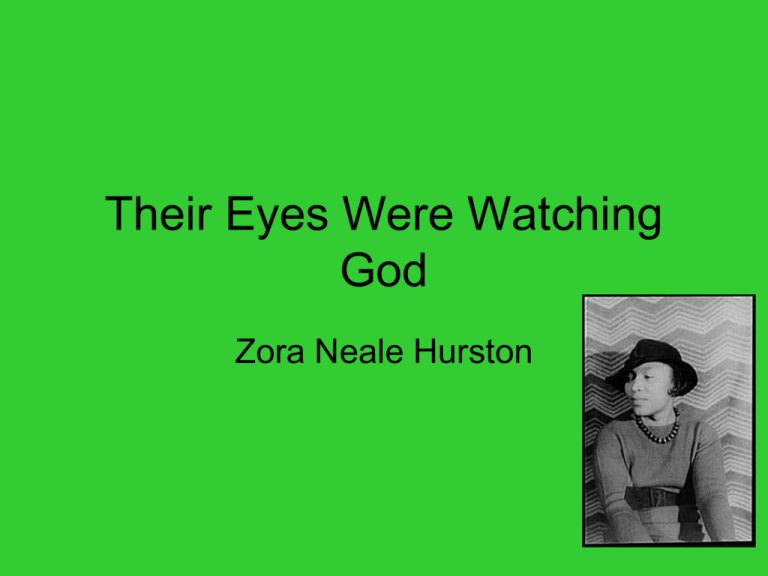
Their Eyes Were Watching God Zora Neale Hurston Zora Neale Hurston • Actually lived in Eatonville, FL, as a child – First all-black incorporated town in the US – Her dad (John) served several terms as mayor • Studied at Howard University (obtained her degree in Literature) – Published in literary magazine • Significant figure in the Harlem Renaissance Harlem Renaissance • Generally, from the end of WW1 through the middle of 1930’s depression – Talented young African-American writers produced a sizable body of literature in the four prominent genres of poetry, fiction, drama, and essay • W. E. B. DuBois introduced the notion of “twoness”: a divided awareness of one’s identity – “One ever feels his two-ness – an American, a Negro; two souls, two thoughts, two unreconciled stirrings; two warring ideals in one dark body, whose dogged strength alone keeps it from being torn asunder.” • Common themes of the Harlem Renaissance writers – – – – Alienation Marginality Use of folk material Use of the blues tradition • More than just a literary movement – Included racial consciousness – “back to Africa” movement, led by Marcus Garvey – Racial integration – Explosion of music, particularly jazz, spirituals, and blues – Painting – Dramatic revues • Hurston, Langston Hughes, and Wallace Thurman organized the journal Fire!, considered one of the defining publications of the era • Hurston studied anthropology at Barnard College (obtained anthropology degree) • Her writing was influenced by her anthropological research on rural black folklore • Incorporates BVE (Black Vernacular English) into • Eyes was published in 1937, long after “heydey” of the Harlem Renaissance – 1930s brought an end to the sense of cultural openness that allowed the renaissance to flourish – Political tension increased and social realism dominated cultural ideas • Art should be political and expose social injustice – Richard Wright (Native Son, Black Boy) wrote that Hurston’s novel was not “serious fiction” and that it “carries no theme, no message, no thought.” • Hurston refused to “honor” gender conventions – Her behavior sometimes seemed shocking – Fell into obscurity for a number of years • By late 1940’s she was having trouble getting published – By 1950’s she was working as a maid – In the late 1950’s she suffered a stroke and entered a rest home in Florida – Died penniless in 1960 and was buried in an unmarked grave • In late 60s, Alice Walker rediscovered Hurston’s work • In 1973, Walker traveled to Florida and marked Hurston’s grave with the phrase “A Genius of the South” • Walker’s 1975 essay, “In Search of Zora Neale Hurston,” published in Ms magazine, brought about new interest in her work • Spike Lee’s film She’s Gotta Have It is a modern adaptation of the novel BVE Dialect makes the story come to life and makes the characters real • • • • • • • • • • • Initial and final consonants are frequently dropped. “You” becomes “yuh,” occasionally “y’all,” a plural. “I” is invariably “Ah.” Vowel shifts also occur often. For example, “get” becomes “git.” The final “r” is “ah.” “Us” may occur as the nominative, and verbs, especially auxiliary verbs, are generally left out. A double negative such as “Nobody don’t know” gives emphasis. Distortions of the past tense also occur. For example, “knew” becomes “knowed.” Because “–ed” is a sign of the simple past, it is logical in dialect to add “-ed” to make a past tense verb. The reflexive pronoun “himself” becomes “hisself.” A final “th” is spoken as “f,” and although the final “r” is softened in some words, it is added to others. In addition to patterns of dialect, Janie and her friends speak a language rich in a vocabulary of localisms and folklore references. These features are also characteristic of regional speech and help make dialects distinctive. • [Review by George Stevens, The Saturday Review of Literature, 18 September 1937:] • Whether or not there was ever a town in Florida inhabited and governed entirely by Negroes, you will have no difficulty believing in the Negro community which Zora Neale Hurston has either reconstructed or imagined in this novel. The town of Eatonville is as real in these pages as Jacksonville is in the pages of Rand McNally; and the lives of its people are rich, racy, and authentic. Major Characters • Janie – Dreams of love and wonders whether love will come with marriage • Nanny – Born into slavery on a plantation, she bears Leafy. Nanny dotes on her grandchild, Janie • Mrs. Washburn – Nanny’s employer and benefactor • Logan Killicks – Janie’s first husband • Joe Starks – Janie’s second husband and the mayor of Eatonville • Vergible “Tea Cake” Woods – Janie’s third husband • Pheoby Watson – Janie’s best friend and confidante – She can be trusted to listen to Janie’s story Frame Structure (story within a story) • The novel begins and ends with two people, Janie and Pheoby, sitting on the porch of Janie’s house – Janie tells her stories to Pheoby during the course of an evening • Janie begins with what has happened in the years since she left Eatonville and memories of her childhood • Story proceeds chronologically • Narration is not firstperson – Hurston uses third-person point of view – Reader encounters Janie’s experiences and Janie faced them, and Hurston controls the story • Frame gives Janie a voice in the novel – Lets Hurston show her gaining strength and independence Four Units to the Framework Janie’s childhood and adolescent years with Nanny *details Nanny’s wish that Janie Has a better life *emphasizes Nanny’s protective love *explores Janie’s feelings about love Janie’s marriage to Tea Cake *True freedom and Independence *True happiness Reader’s learn Nanny’s story; Janie’s loss of childhood after she marries Logan Killicks Janie’s years with Joe Starks *Happiness and dissatisfaction *Suffering from possessive love *Janie fosters her strength and autonomy
